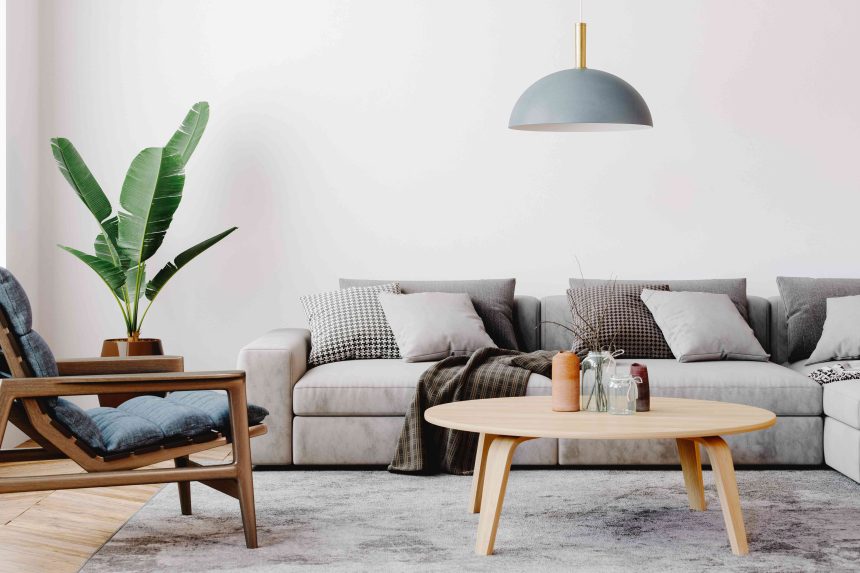Choosing the right coffee table for your space can be absolutely transformative. While it can create a more functional layout, it can also draw a room together, providing a central zone where friends and family can gather. But before you start mapping out your coffee table conversations, it’s important to get the furnishing right.
Choosing a coffee table should come down to the size of your space, the size of your sofa or seating arrangement, how you plan to use the table, and the desired design style for the space. Go too small and you’ll have a table that doesn’t function properly and looks disproportionate among the other furnishings. Opt for one that’s too big and you could have traffic flow problems.
To get the dimensions just right, we’re breaking down everything you need to consider when it comes to size, shape, and placement of your coffee table.
Measuring for a Coffee Table
The length of your coffee table should be about 2/3 the length of your sofa. So a 6-foot coffee table would be best suited for a 9-foot sofa. This ensures the table is easily reachable regardless of where you or your guests are sitting on the couch.
When it comes to determining the proper width of the coffee table, take into consideration the overall size of your room or the dimensions of the seating area. Measure about 12 to 18 inches of clearance between your coffee table and your sofa to allow for proper traffic flow. Allow for about 30 inches from the far end of your coffee table to larger furnishings like a tv stand, fireplace, or console.
Want more design inspiration? Sign up for our free daily newsletter for the latest decor ideas, designer tips, and more!
Choosing the Right Coffee Table Size
When you’re measuring a coffee table, start with the existing furnishings in the room that will be in range of the coffee table: arm chairs, a sofa, loveseat, or sectional. In most situations, the coffee table will be placed just in front of a sofa or couch.
The width and length of your coffee table will vary based on your desired style as well as the shape of the table you select. Aim for a coffee table that is about 2/3 the length of your sofa or primary seating arrangement. This can provide a more proportional look in your space.
Width is one dimension that can be more personalized, with less of an emphasis on precise dimensions but more in line with how the piece will be used. For coffee tables that will just be used for a coffee cup or a few glasses of wine in the evening, a more narrow table should suite. But if you prefer to decorate your table with large coffee table books, decorative objects, and plants or flower arrangements in addition to still being a landing spot for drinks and other items, then you might require a more expansive surface area.
Choosing the Right Shape
There are a variety of coffee table shapes to choose from, each with its own benefits including which orientation or style for which they’re best suited.
- Oval: An oval-shaped coffee table can work for longer sofas and larger spaces. The curved lines can soften the overall look of the room, working particularly well to balance more modern sofa types.
- Rectangular: Rectangular coffee tables are popular for their ability to work with longer sofas while taking up a smaller footprint than wider varieties. It works well for an array of design styles ranging from traditional to modern and everything in between.
- Round: Go for a round coffee table when you’re working with a smaller space or are looking for a coffee table for a smaller seating area. It works with a range of design styles and, like oval coffee tables, can help create a softer look within the space thanks to its curved edges.
- Square: A square coffee table can work particularly well with a sectional where it can provide an equal surface area within arm’s reach for placing a beverage, book, or other item on the table no matter where you’re seated on the sofa.
Choosing the Right Coffee Table Height
The height of your coffee table should be similar to that of your sofa. Start by measuring the height of your couch from the floor to the top of the seating cushion. Selecting a coffee table that corresponds to that measurement (or one to two inches lower) should provide a proportional look.
Most coffee tables will range in height from 16 to 18 inches, but there are options that provide a lower profile in order to work with furnishings that are lower to the ground, often lending a more modern or streamlined effect.
Choosing the Right Placement for a Coffee Table
When determining the right placement for a coffee table, use painter’s tape to map it out. This can give you a better idea of how the space will look and function once your coffee table is in place. It can also allow you to tweak the placement and orientation until it works for you and your space.
Allow your room’s focal point or desired layout to direct your coffee table placement. Traditionally, a coffee table is placed in front of a sofa, allowing 12 to 18 inches between both furnishings to allow for proper leg space without sacrificing the proximity of the tabletop. An additional clearance of 30 inches between the far end of the coffee table and the wall, media console, or other large furnishings is necessary to ensure proper traffic flow.
FAQ
-
There isn’t an overall standard size for a coffee table though most coffee tables will range in height from 16 inches to 18 inches. The width and length of the coffee table will be dependent on the size of the corresponding furniture.
-
While 12 inches is certainly on the low side for a coffee table, it can work for certain furnishing arrangements and styles, particularly when a more contemporary aesthetic is desired.
-
Rectangular coffee tables are one of the most popular choices because their surface area can be well suited for larger seating areas, providing tabletop access within an arm’s reach for more dwellers within the room.








